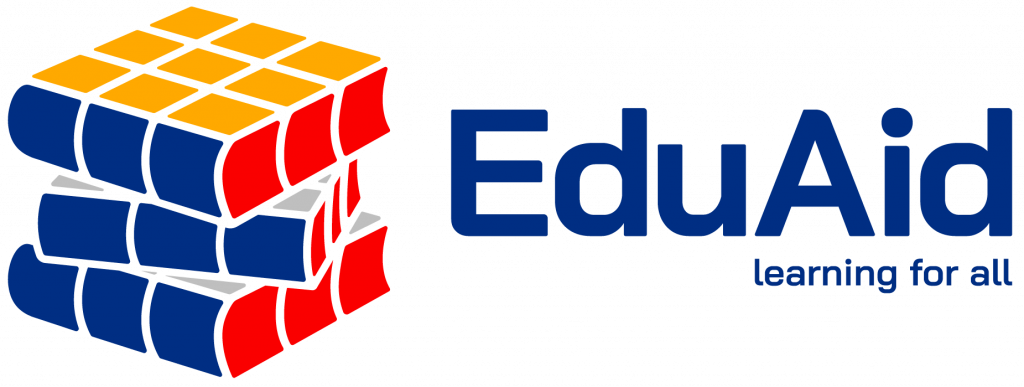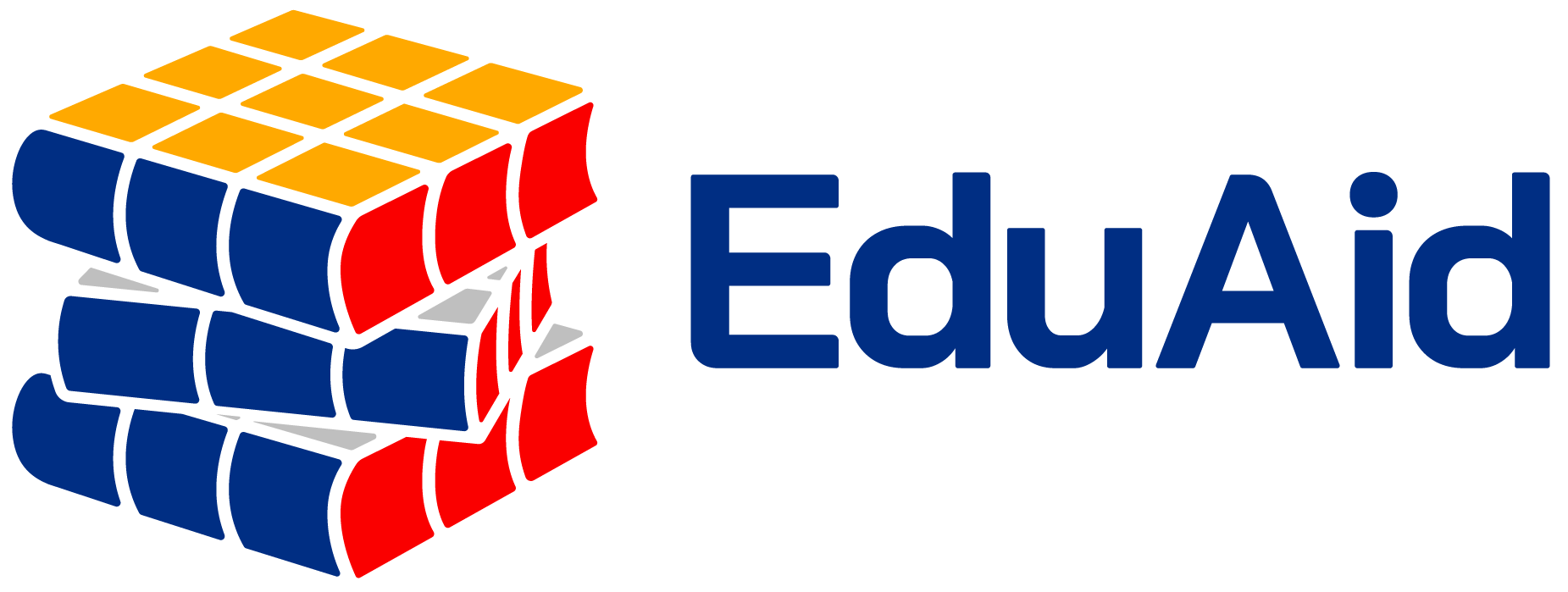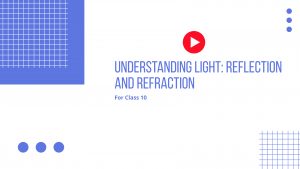NCERT Solutions for Maths Class 10 Chapter 12
Exercise 12.1
Question 1:
The radii of two circles are 19 cm and 9 cm respectively. Find the radius of the circle which has circumference equal to the sum of the circumferences of the two circles.
Answer:
Radius (r1) of 1st circle = 19 cm
Radius (r2) or 2nd circle = 9 cm
Let the radius of 3rd circle be r.
Circumference of 1st circle = 2πr1 = 2π (19) = 38π
Circumference of 2nd circle = 2πr2 = 2π (9) = 18π
Circumference of 3rd circle = 2πr
Given that,
Circumference of 3rd circle=Circumference of 1st
Circle + Circumference of 2nd circle 2πr = 38π + 18π = 56π
\(r=\frac{56\pi}{2\pi}=28\)
Therefore, the radius of the circle which has circumference equal to the sum of the circumference of the given two circles is 28 cm.
Question 2:
The radii of two circles are 8 cm and 6 cm respectively. Find the radius of the circle having area equal to the sum of the areas of the two circles.
Answer:
Radius (r1) of 1st circle = 8 cm
Radius (r2) of 2nd circle = 6 cm
Let the radius of 3rd circle be r.
Area of 1st circle \(πr_1^2=π(8)^2=64π\)
Area of 2nd circle \(=πr_2^2=π(6)^2=36π\)
Given that,
Area of 3rd circle = Area of 1st circle + Area of 2nd circle
\(=πr^2=πr_1^2+πr_2^2\)
\(=πr^2=64π+36π\)
\(=πr^2=100π\)
\(r^2=100\)
\(r=±10\)
However, the radius cannot be negative. Therefore, the radius of the circle having area equal to the sum of the areas of the two circles is 10 cm.
Question 3: Given figure depicts an archery target marked with its five scoring areas from the centre outwards as Gold, Red, Blue, Black and White. The diameter of the region representing Gold score is 21 cm and each of the other bands is 10.5 cm wide. Find the area of each of the five scoring regions. [Use \(\pi=\frac{22}{7}\)]
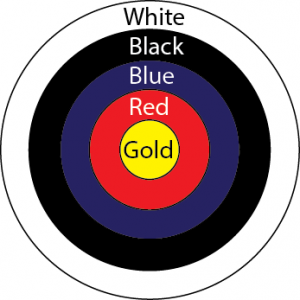
Answer:
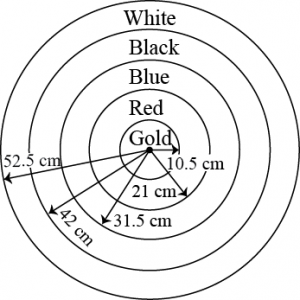
Answer:
Radius (r1) of gold region (i.e., 1st circle) \(\frac{21}{2}10.5\) cm
Given that each circle is 10.5 cm wider than the previous circle.
Therefore, radius (r2) of 2nd circle = 10.5 + 10.5 21 cm
Radius (r3) of 3rd circle = 21 + 10.5 = 31.5 cm
Radius (r4) of 4th circle = 31.5 + 10.5 = 42 cm
Radius (r5) of 5th circle = 42 + 10.5 = 52.5 cm
Area of gold region = Area of 1st circle
\(=πr_1^2=π(10.5)^2=346.5\space cm^2\)
Area of red region = Area of 2nd circle − Area of 1st circle
\(=πr_2^2-πr_1^2\)
\(=π(21)^2-π(10.5)^2\)
\(=441π-110.25π=330.75π\)
\(=1039.5\space cm^2\)
Area of blue region = Area of 3rd circle − Area of 2nd circle
\(=πr_3^2-πr_1^2\)
\(=π(31.5)^2-π(21)^2\)
\(=992.25π-441π=551.25π\)
\(=1732.5\space cm^2\)
Area of black region = Area of 4th circle − Area of 3rd circle
\(=πr_4^2-πr_3^2\)
\(=π(42)^2-π(31.5)^2\)
\(=1764π-992.25π\)
\(=771.75π=2425.5\space cm^2\)
Area of white region = Area of 5th circle − Area of 4th circle
\(=πr_5^2-πr_4^2\)
\(=π(52.5)^2-π(42)^2\)
\(=2756.25π-1764π\)
\(=992.25π=3118.5\space cm^2\)
Therefore, areas of gold, red, blue, black, and white regions are 346.5 cm2, 1039.5 cm2, 1732.5 cm2, 2425.5 cm2, and 3118.5 cm2 respectively.
Question 4: The wheels of a car are of diameter 80 cm each. How many complete revolutions does each wheel make in 10 minutes when the car is traveling at a speed of 66 km per hour? [Use \(\pi=\frac{22}{7}\)]
Answer:
Diameter of the wheel of the car = 80 cm
Radius (r) of the wheel of the car = 40 cm
Circumference of wheel = 2πr
= 2π (40) = 80π cm Speed of car = 66 km/hour
\(=\frac{66\times100000}{60}\) cm/min
\(=110000\) cm/min
Distance travelled by the car in 10 minutes
= 110000 × 10 = 1100000 cm
Let the number of revolutions of the wheel of the car be n.
n × Distance travelled in 1 revolution (i.e., circumference)
= Distance travelled in 10 minutes
\(n×80π=1100000\)
\(n=\frac{1100000×7}{80×22}\)
Therefore, each wheel of the car will make 4375 revolutions.
Question 5: Tick the correct answer in the following and justify your choice: If the perimeter and the area of a circle are numerically equal, then the radius of the circle is (A) 2 units (B) π units (C) 4 units (D)7 units
Answer:
Let the radius of the circle be \(r\).
Circumference of circle = 2πr
Area of circle = πr2
Given that, the circumference of the circle and the area of the circle are equal.
This implies 2πr = πr2
2 = r
Therefore, the radius of the circle is 2 units.
Exercise 12.2
Question 1: Find the area of a sector of a circle with radius 6 cm if angle of the sector is \(60^0\). [Use \(\pi=\frac{22}{7}\)]
Answer:
Let\(OACB\) be a sector of the circle making \(60^0\) angle at centre \(O\) of the circle.
Area of sector of angle \(θ=\frac{θ}{360^0}\times\pi r^2\)
Area of sector \(OACB=\frac{60^0}{360^0}\times\frac{22}{7}\times (6)^2\)
\(=\frac{1}{6}\times\frac{22}{7}\times6\times6=\frac{132}{7}\space cm^2\)
Therefore, the area of the sector of the circle making \(60^0\) at the centre of the circle is \(\frac{132}{7}\space cm^2\)
Question 2: Find the area of quadrant of a circle whose circuference is \(22\space cm\).
Answer:
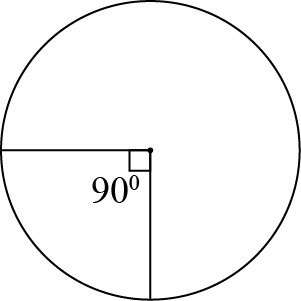
Let the radius of the circel be \(r\).
Circumference \(=22\space cm\)
\(2\pi r =22\space dd\)
\(r=\frac{22}{2\pi}=11/\pi d\)
Quadrant of circle will subtend \(90^0\) angle at the centre of the circle.
Area of such quadrant of the circle \(=\frac{90^0}{360^0}\times\pi\times r^2\)
\(=\frac{1}{4\pi r}\times(\frac{11}{\pi})^2\)
\(=\frac{121}{4\pi}=\frac{121\times7}{4\times22}\)
\(=\frac{77}{8}\space cm^2\)
Question 3: The length of the minute hand of a clock is 14 cm. Find the area swept by the minute hand in 5 minutes. [Use\(\pi=\frac{22}{7}\)]
Answer:
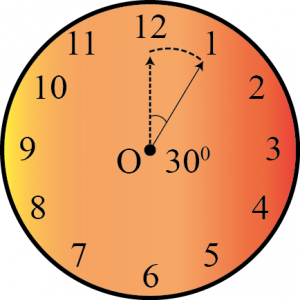
We know that in 1 hour (i.e., 60 minute), the minute hand rotates \(360^0\).
In 5 minutes, minute hand will rotate \(=\frac{360^0}{60}\times 5=30^0\)
Therefore, the area swept by the minute hand in 5 minutes will be the area of a sector of \(30^0\) in a circle of \(14\space cm\) radius.
Area of sector of angle \(\theta=\frac{\theta}{360^0}\times \pi r^2\)
Area of sector of angle \(30^0=\frac{30^0}{360^0}\times\frac{22}{7}\times 14\times14\)
\(=\frac{22}{12}\times2\times14\)
\(=\frac{11\times14}{3}\)
\(=\frac{154}{3}\space cm^2\)
Therefore, the area swept by the minute hand 5 minutes is \(\frac{14}{3}\space cm^2\).
Question 4: A chord of a circle of radius 10 cm subtends a right angle at the centre.
Find the area of the corresponding:
(i) Minor segment
(ii) Major sector
[Use π = 3.14]
Answer:
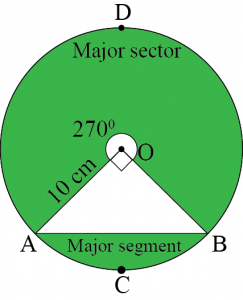
Let \(AB\) be the chor of the circle subtending \(90^0\) angle at centre \(O\) of the circle.
Area of major sector \(OADB=(\frac{360^0-90^0}{360^0})\times\pi r=(\frac{270^0}{360^0}\pi r^2\)
\(\frac{3}{4}\times3.14\times10\times10\)
\(=235.5\space cm^2\)
Area of minor sectoe \(OACB=\frac{90^0}{360^0}\times \pi r^2\)
\(=\frac{1}{4}\times3.14\times10\times10\)
\(=78.5\space cm^2\)
Area of \(ΔOAB = \frac{1}{2}×OA×OB=\frac{1}{2}×10×10\)
\(=50\space cm^2\)
Area of minor segment \(ACB=\) Area of minor sector \(OACB\) Area of \(ΔOAB=78.5−50=28.5 cm^2\)
Question 5: In a circle of radius \(21\space cm\), an arc subtends an angle of \(60^0\) at the centre. Find:
(i) The length of the arc
(ii) Area of the sector formed by the arc
(iii) Area of the segment forced by the corresponding chord
[Use \(\pi=\frac{22}{7}\)]
Answer:
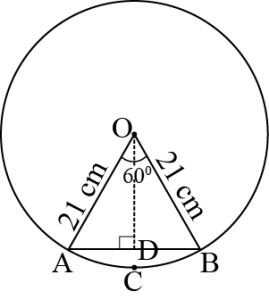
Radius \((r)\) of circle \(=21\space cm\)
Angle subtended by the given arc \(=60^0\)
Length of an arec of a sector of angle \(\theta=\frac{\theta}{360^0}\times 2\pi r\)
Length of arc \(ACB=\frac{60^0}{360^0}\times2\times2\frac{22}{7}\times21\)
\(=\frac{1}{6}\times2\times22\times3\)
\(=22\space cm\)
Area of sector \(OACB=\frac{60^0}{360^0}\times \pi r^2\)
\(=\frac{1}{6}\times\frac{22}{7}\times21\times21\)
\(=231\space cm^2\)
In \(ΔOAB\),
\(∠OAB = ∠OBA (As OA = OB)\)
\(∠OAB + ∠AOB + ∠OBA = 180^0\)
\(2∠OAB + 60^0 = 180^0\)
\(∠OAB = 60^0\)
Therefore, \(ΔOAB\) is an equilateral triangle.
Area of \(ΔOAB=\frac{\sqrt3}{4}\times(Side)^2\)
\(=\frac{\sqrt3}{4}\times(21)^2=\frac{441\sqrt3}{4}cm^2\)
Area of segment \(ACB=\) Area of sector \(OACB\)- Area of \(ΔOAB\)
\(=(231-\frac{441\sqrt3}{4}cm^2\)
Question 6: A chord of a circle of radius 15 cm subtends an angle of 60° at the centre. Find the areas of the corresponding minor and major segments of the circle. [Use π = 3.14 and \(\sqrt3=1.73\) ]
Answer:
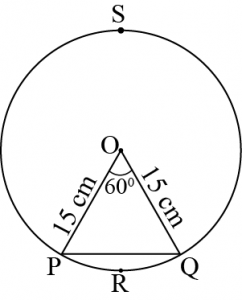
Radius (r) of circle = 15 cm
Area of sector \(OPRQ=\frac{60^0}{360^0}\times \pi r^2\)
\(=\frac{1}{6}\times3.14\times (15)^2\)
\(=117.75\space cm^2\)
In \(ΔOPQ\),
\(∠OPQ = ∠OQP (As OP = OQ)\)
\(∠OPQ + ∠OQP + ∠POQ = 180^0\)
\(2 ∠OPQ = 120^0\)
\(∠OPQ = 60^0\)
\(ΔOPQ\) is an equilateral triangle.
Area of \(ΔOPQ=\frac{\sqrt3}{4}\times(Side)^2\)
\(=\frac{\sqrt3}{4}\times(15)^2=\frac{225\sqrt3}{4}cm^2\)
\(=56.25\sqrt3\)
\(=97.3125\space cm^2\)
Area of segment \(PRQ =\) Area of sector \(OPRQ − \) Area of \(ΔOPQ\)
\(= 117.75 − 97.3125\)
\(= 20.4375 cm^2\)
Area of major segment \(PSQ =\) Area of circle − Area of segment \(PRQ\)
\(=π(15)^2-20.4375\)
\(=3.14×225-20.4375\)
\(=706.5-20.4375\)
=686.0625 cm^2
Question 7: A chord of a circle of radius 12 cm subtends an angle of 120° at the centre. Find the area of the corresponding segment of the circle. [Use \(π = 3.14\) and \(\sqrt3=1.73\)]
Answer:
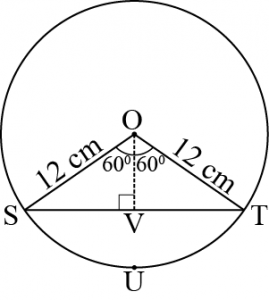
Let us draw a perpendicular \(OV\) on chord \(ST\).
It will bisect the chord \(ST. SV = VT\)
In \(ΔOVS\),
\(\frac{OV}{OS}=cos\space 60^0\)
\(\frac{OV}{12}=\frac{1}{2}\)
\(OV=6\space cm\)
\(\frac{SV}{SO}=sin\space 60^0=\frac{\sqrt3}{2}\)
\(\frac{SV}{12}=\frac{\sqrt3}{2}\)
\(\frac{SV}{12}=\frac{\sqrt3}{2}\)
\(SV=6\sqrt3\space cm\)
\(ST=2SV=2\times6\sqrt3=12\sqrt3\space cm\)
Area of \(ΔOST=\frac{1}{2}\times ST\times OV\)
\(=\frac{1}{2}\times12\sqrt3\times6\)
\(=36\sqrt3=36\times1.73=62.28\space cm^2\)
Area of sector \(OUST=\frac{120^0}{360^0}\times\pi(12)^2\)
\(=\frac{1}{3}\times3.14\times144=150.72\space cm^2\)
Area of segmet \(SUT=\) Area of sector \(OSUT-\) Area of \(ΔOST\)
\(=150.72-62.28\)
\(=88.44\space cm^2\)
Question 8: A horse is tied to a peg at one corner of a square shaped grass field of side 15 m by means of a 5 m long rope (see the given figure). Find
(i) The area of that part of the field in which the horse can graze.
(ii) The increase in the grazing area of the rope were 10 m long instead of 5 m. [Use π = 3.14]
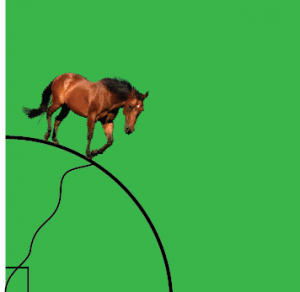
Answer:
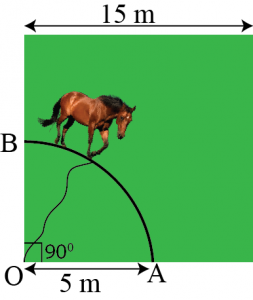
From the figure, it can be observed that the horse can graze a sector of 90\(90^0\) in a circle of \(5\space m\) radius.
Area that can be grazed by horse = Area of sector \(OACB\)
\(=\frac{90^0}{360^0}\pi r^2\)
\(=\frac{1}{4}\times3.14\times(5)^2\)
\(=19.625\space m^2\)
Area that can be grazed by the horse
when length of rope is \(10\space m\) long
\(=\frac{90^0}{360^0}\times \pi\times(10)^2\)
\(=\frac{1}{4}\times3.14\times100\)
\(=78.5\space m^2\)
Increasing in grazing area \(=(78.5-19.625)m^2\)
\(=58.875\space m^2\)
Question 9: A brooch is made with silver wire in the form of a circle with diameter 35 mm. The wire is also used in making 5 diameters which divide the circle into 10 equal sectors as shown in figure. Find.
(i) The total length of the silver wire required.
(ii) The area of each sector of the brooch
[Use \(\pi=\frac{22}{7}\)]
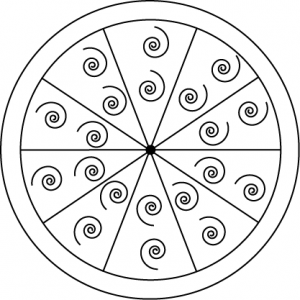
Answer:
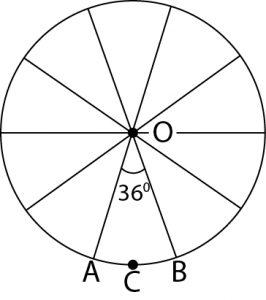
Total length of wire required will be the length of 5 diameters and the circumference of the brooch.
Radius of circle \(=\frac{35}{2}\space mm\)
Circumference of brooch \(=2\pi r\)
\(=2\times\frac{22}{7}\times(\frac{35}{2}\)
\(=110\space mm\)
Length of wire required \(= 110 + 5 × 35\)
\(= 110 + 175 = 285\space mm\)
It can be observed from the figure that each of \(10\) sectors of the circle is subtending \(36^0\) at the centre of the circle
Therefore, area of each sector \(=\frac{36^0}{360^0}\times\pi r^2\)
\(=\frac{1}{10}\times\frac{22}{7}\times(\frac{35}{2}\times(\frac{35}{2})\)
\(=\frac{385}{4}mm^2\)
Therefore , area of each sector \(=\frac{36^0}{360^0}\times\pi r^2\)
\(=\frac{1}{10}\times\frac{22}{7}\times(\frac{35}{2})\times(\frac{35}{2})\)
\(=\frac{385}{4}\space mm^2\)
Question 10: An Umbrella has \(8\) ribs which are equally (see figure). Assuming umbrella to be a flat circle of radius \(45\space cm\), find the area between the two consecutive ribs of the umbrella. [Use \(\pi=\frac{22}{7}\)]
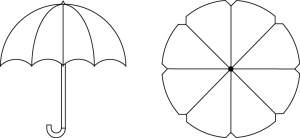
Answer:
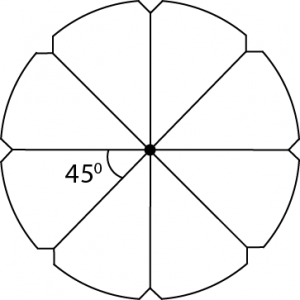
There are 8 ribes in an umbrella.
The area between two consecutive ribs is subtending \(\frac{360^0}{8}=45^0\) at the centre of the assumed flat circle.
Area between two consecutive ribs of circle
\(=\frac{45^0}{360^0}\times\pi r^2\)
\(=frac{1}{8}\times \frac{22}{7}\times (45)^2\)
\(=\frac{11}{28}\times2025\)
\(=\frac{22275}{28}\space cm^2\)
Question 11: A car has two wipers which do not overlap. Each wiper has blade of length \(25\space cm\) sweeping through an angle of \(115^0\) . Find the total area cleaned at each sweep of the blades. [Use \(\pi=\frac{22}{7}\)]
Answer:
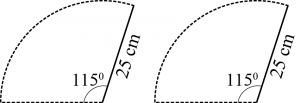
In can be observed from the figure that each blade of wiper will sweep an area of a sector of \(115^0\) in a circle of \(25\space cm\) radius.
Area of such sector
\(=\frac{115^0}{360^0}\times\pi\times(25)^2\)
\(=\frac{23}{72}\times \frac{22}{7}\times25\times25\)
\(=\frac{158125}{525}\space cm^2\)
Area swept by \(2\) blades
\(=2\times\frac{158125}{252}\)
\(=\frac{158125}{126}cm^2\)
Question 12: To warn ships for underwater rocks, a lighthouse spreads a red coloured light over a sector of angle \(80^0\) to a distance of \(16.5\space km\). Find the area of the sea over which the ships warned. [Use \(π = 3.14\)]
Answer:
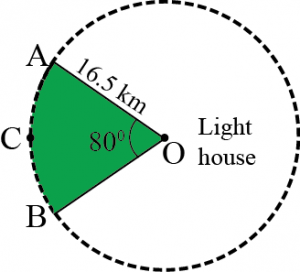
It can be observed from the figure that the lighthouse spreads light across a sector of \(80^0\) in a circle of \(16.5\space km\) radius.
Area of sector \(OACB=\frac{80^0}{360^0}\times\pi r^2\)
\(=\frac{2}{9}\times3.14\times16.5\times16.5.\)
\(=189.97\space km^2\)
Question 13: A round cove has six equal designs as shownn in figure. If the radius of the cover is \(28\space cm\), find the cost of making the designs at the rate of \(Rs.\space0.35\) per \(cm^2\). {Use \(\pi=\sqrt3=1.7\)]
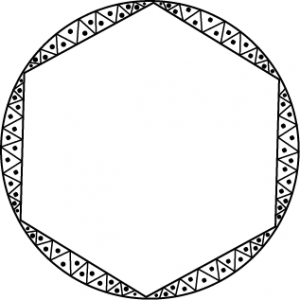
Answer:
It can be observed that these designs are segments of the circle.
Consider segment APB.
Chord AB is a side of the hexagon.
Each chord will substitute \(\frac{360^0}{6}=60^0\) at the centre of the circle.
In \(\Delta OAB\),
\(∠OAB = ∠OBA (As OA = OB)\)
\(∠AOB = 60^0\)
\(∠OAB + ∠OBA + ∠AOB = 180^0\)
\(2∠OAB = 180^0 − 60^0 = 120^0\)
\(∠OAB = 60^0\)
Therefore, \(ΔOAB\) is an equilateral triangle.
Area of \(\Delta OAB=\frac{\sqrt3}{4}\times(Side)^2\)
\(=\frac{\sqrt3}{4}\times(28)^2\times196\sqrt3=196\sqrt3=196\times1.7\)
\(=333.2\space cm^2\)
Area of sector \(OAPB=\frac{60^0}{360^0}\times\pi r^2\)
\(=\frac{1}{6}\times\frac{22}{7}\times28\times28\)
\(=\frac{1232}{3}\space cm^2\)
Area of segment \(APB=\) Area of sector \(OAPB-\) Area of \(\Delta OAB\)
\(=(\frac{1232}{3}-333.2)\space cm^2\)
Therefore, area of designs \(=6\times(\frac{1232}{3}-333.2)\space cm^2\)
\(=2464-1999.2)\space cm^2\)
\(=454.8\space cm^2\)
Cost of making \(1\space cm^2\) designs \(=Rs.\space 0.35\)
Cost of making \(464.76\space cm^2\) designs \(=464.8\times0.35=Rs.\space 162.68\)
Therefore, the cost of making such designs is Rs. \(162.68\)
Question 14:
Tick the correct answer in the following:
Area of a sector of angle p (in degrees) of a circle with radius \(R\) is
a. \(\frac{p}{180}\times2\pi\space R\)
b. \(\frac{p}{180}\times\pi\space R^2\)
c. \(\frac{p}{360}\times2\pi\space R\)
d. \(\frac{p}{720}\times2\pi\space R^2\)
Answer:
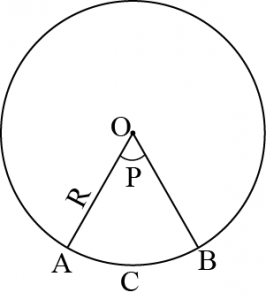
We know that area of sector of angle \(\theta=\frac{theta}{360^0}\times\pi\space R^2\)
Area of sector of angle \(P=\frac{p}{360^0}(\pi R^2)\)
\(=(\frac{p}{720^0})(2\pi R^2)\)
Exercise 12.3
Question 1: Find the area of the shaded region in the given figure, if \(PQ = 24\space cm,\space PR = 7\space cm\) and \(O\) is the centre of the circle. [Use \(\pi=\frac{22}{7}\)]
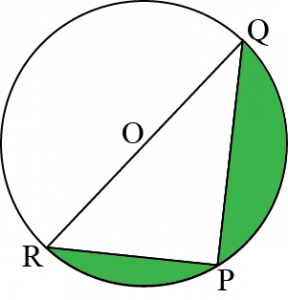
Answer:
It can be observed that \(RQ\) is the diameter of the circle.
Therefore, \(∠RPQ\) will be \(90^0\).
By applying Pythagoras theorem in \(ΔPQR\),
\(RP^2+PQ^2=RQ^2\)
\((7)^2+(24)^2=RQ^2\)
\(RQ=\sqrt{625}=25\)
Radius of circle, \(OR=\frac{RQ}{2}=\frac{25}{2}\)
Since \(RQ\) is the diameter of the circle, it divides the circle two parts.
Area of semi-circle \(RPQOR=\frac{1}{2}\pi r^2\)
\(=\frac{1}{2}\pi(\frac{25}{2})^2\)
\(=\frac{1}{2}\times\frac{22}{7}\times\frac{625}{4}\)
\(=\frac{6875}{28}\space cm^2\)
Area of \(\Delta PQR=\frac{1}{2}\times PQ\times PR\)
\(=\frac{1}{2}\times24\times7\)
\(=84\space cm^2\)
Ara of shaded region = Area of semi-circle \(RPQOR-\) Area of \(\Delta PQR\)
\(=\frac{6875}{28}-84\)
\(=\frac{6875-2352}{28}\)
\(=\frac{4523}{28}\space cm^2\)
Question 2: Find the area of the shaded region in the given figure, if radii of the two concentric circles with centre \(O\) are \(7\space cm\) and \(14\space cm\) respectively and \(∠AOC = 40^0\). [Use \(\pi=\frac{22}{7}\)]
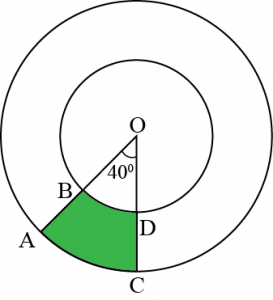
Answer:
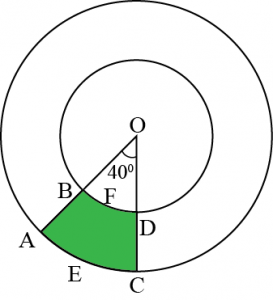
Answer:
Radius of inner circle = 7 cm
Radius of outer circle = 14 cm
Area of shaded region
Area of sector OAFC − Area of sector OBED
\(=\frac{40^0}{360^0}\times\pi(14)^2=\frac{40^0}{360^0}\times\pi(7)^2\)
\(=\frac{1}{9}\times\frac{22}{7}\times14\times14-\frac{1}{9}\times\frac{22}{7}\times7\times7\)
\(=\frac{616}{9}-\frac{154}{9}=\frac{462}{9}\)
\(=\frac{154}{3}\space cm^2\)
Question 3: Find the area of the shaded region in the given figure, if ABCD is a square of side 14 cm and APD and BPC are semicircles. [Use \(\pi=\frac{22}{7}\)]
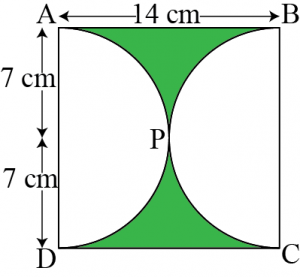
Answer:
It can be observed from the figure that the radius of each semi-circle is 7 cm.
Area of each semi-circle \(=\frac{1}{2}\pi r^2\)
\(=\frac{1}{2}\times\frac{22}{7}\times(7)^2\)
\(=77\space cm^2\)
Area of square \(ABCD = (Side)^2 = (14)^2 = 196\space cm^2\)
Area of the shaded region = Area of square ABCD − Area of semi-circle
APD − Area of semi-circle BPC
\(= 196 − 77 − 77 = 196 − 154 = 42\space cm^2\)
Question 4: Find the area of the shaded region in the given figure, where a circular arc of radius 6 cm has been drawn with vertex O of an equilateral triangle OAB of side 12 cm as centre. [Use \(\pi=\frac{22}{7}\)]
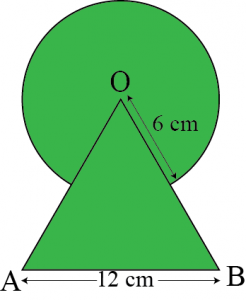
Answer:
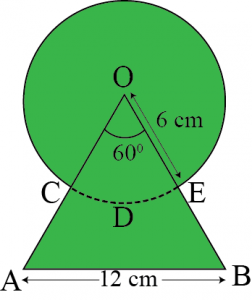
We know that each interior angle of an equilateral triangle is of measure \(60^0\).
Area of sector \(OCDE=\frac{60^0}{360^0}\pi r^2\)
\(=\frac{1}{6}\times\frac{22}{7}\times6\times6\)
\(=\frac{132}{7}\space cm^2\)
Area of \(\Delta OAB=\frac{\sqrt3}{4}(12)^2=\frac{\sqrt3\times12\times12}{4}=36\sqrt3\space cm^2\)
Area of circle \(=\pi r^2=\frac{22}{7}\times6\times6=\frac{792}{7}\space cm^2\)
Area of shaded region = Area of \(\Delta OAB+\) Area of circle – Area of sector \(OCDE\)
\(=36\sqrt3+\frac{792}{7}-\frac{132}{7}\)
\(=(36\sqrt3+\frac{660}{7})\space cm^2\)
Question 5: From each corner of a square of side 4 cm a quadrant of a circle of radius 1 cm is cut and also a circle of diameter 2 cm is cut as shown in the given figure. Find the area of the remaining portion of the square. [Use \(\pi=\frac{22}{7}\)]
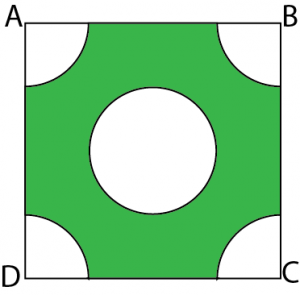
Answer:
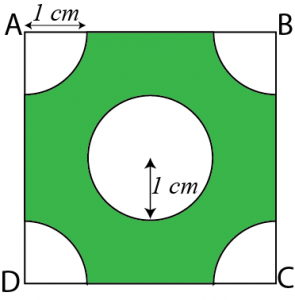
Each quadrant is a sector if \(90^0\) in a circle of \(1\space cm\) radius area of each quardran \(=\frac{90^0}{360^0}\pi r^2\)
\(=\frac{1}{4}\times\frac{22}{7}\times (1)^2=\frac{22}{28}\space cm^2\)
Area of square \(=(Side)^2=(4)^2=16\space cm^2\)
Area of circle \(=\pi r^2=\pi(1)6^2\)
\(=\frac{22}{7}\space cm^2\)
Area of the shaded region
Area of square – Area of circle \(-4\times\) Area of quadrant
\(=16-\frac{22}{7}-4\times\frac{22}{28}\)
\(=16-\frac{22}{7}-\frac{22}{7}=16-\frac{44}{7}\)
\(=\frac{112-44}{7}\)
\(=\frac{68}{7}\space cm^2\)
uestion 6: In a circular table cover of radius 32 cm, a design is formed leaving an equilateral triangle ABC in the middle as shown in the given figure. Find the area of the design (Shaded region). [Use \(\pi=\frac{22}{7}\)]
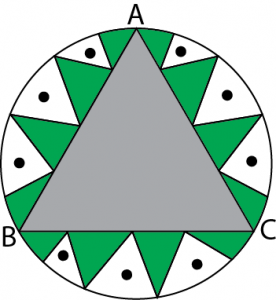
Answer:

Radius (r) of circle = 32 cm
AD is the median of ABC.
\(AO=\frac{2}{3}AD=32\)
\(AD=48\space cm\)
In \(\Delta ABD\),
\(AB^2=AD^2+BD^2\)
\(AB^2=(48)^2+(\frac{AB}{2})^2\)
\(\frac{3AB^2}{4}=(48)^2\)
\(AB=\frac{48\times2}{\sqrt3}=\frac{96}{\sqrt3}=32\sqrt3\space cm\)
Area of equalateral triangle, \(\Delta ABC=\frac{\sqrt3}{4}(32\sqrt3)^2\)
\(=\frac{\sqrt3}{4}\times32\times32\times3=96\times8\times\sqrt3\)
\(=768\sqrt3\space cm^2\)
Area of circle \(=\pi r^2\)
\(=\frac{22}{7}\times(32)^2\)
\(=\frac{22}{7}\times1024\)
\(=\frac{22528}{7}\space cm^2\)
Area of design = Area of circle – Area of \(\Delta ABC\)
\(=(\frac{22528}{7}-768\sqrt3)\space cm^2\)
Question 7: In the given figure, ABCD is a square of side 14 cm. With centres A, B, C and D, four circles are drawn such that each circle touches externally two of the remaining three circles. Find the area of the shaded region. [Use \(\pi=\frac{22}{7}\)
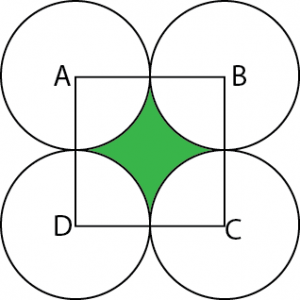
Answer:
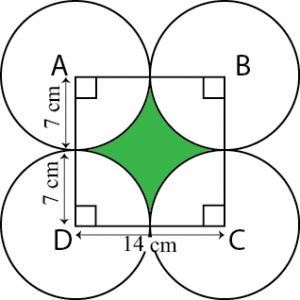
Area of each of the 4 sectors is equal to each other and is a sector of \(90^0\) in a circle of \(7\space cm\) radius.
Area of each sector \(=\frac{90^0}{360^0}\times \pi(7)^2\)
\(=\frac{1}{4}\times\frac{22}{7}\times7\times7\)
\(=\frac{77}{2}\space cm^2\)
Area of square \(ABCD=(Side)^2=(14)^2=196\space cm^2\)
Area of shaded portion = Area of square \(ABCD-4\times\) Ara of each sector
\(=196-4\times\frac{77}{2}=196-154\)
Therfore, the area of shaded portion is \(42\space cm^2\).
Question 8: The given figure depicts a racing track whose left and right ends are semicircular.
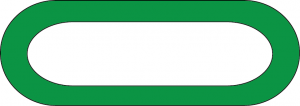
The distance between the two inner parallel line segments is 60 m and they are each 106 m long. If the track is 10 m wide, find: [Use \(\pi=\frac{22}{7}\)]
(i) The distance around the track along its inner edge
(ii) The area of the track
Answer:
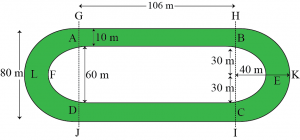
Distance around the track along its inner edge = AB + arc BEC + CD + arc DFA
\(=106+\frac{1}{2}×2πr+106+\frac{1}{2}×2πr\)
\(=212+\frac{1}{2}×2×\frac{22}{7}×30+\frac{1}{2}×2×\frac{22}{7}×30\)
\(=212+2×\frac{22}{7}×30\)
\(=212+\frac{1320}{7}\)
\(=212+\frac{1320}{7}\)
\(=\frac{1484+1320}{7}=\frac{2804}{7}\space m\)
Area of the track = (Area of GHIJ − Area of ABCD) + (Area of semi-circle HKI − Area of semi-circle BEC) + (Area of semi-circle GLJ − Area of semi-circle AFD)
\(106×80-106×60+\frac{1}{2}×\frac{22}{7}×(40)^2\)
\(-\frac{1}{2}×\frac{22}{7}×(30)^2+\frac{1}{2}×\frac{22}{7}×(40)^2\)
\(-\frac{1}{2}×\frac{22}{7}×(30)^2\)
\(=106(80-60)+\frac{22}{7}×(40)^2-\frac{22}{7}×(30)^2\)
\(=106(20)+\frac{22}{7}[(40)^2-(30)^2 ] \)
\(=2120+(\frac{22}{7})(40-30)(40+30)\)
\(=2120+(\frac{22}{7})(10)(70)\)
\(=2120+2200\)
Therefore, the area of the track is \(4320\space m^2\).
\(=4320 \space m^2\)
Question 9: In the given figure, AB and CD are two diameters of a circle (with centre O) perpendicular to each other and OD is the diameter of the smaller circle. If OA = 7 cm, find the area of the shaded region. [Use \(\pi=\frac{22}{7}\)]
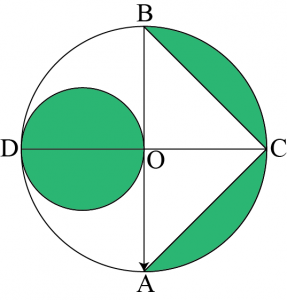
Answer:
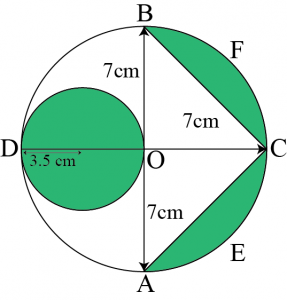
Radius \((r_1)\) of larger circle \(=7\space cm\)
Radius \((r_2)\) of smaller circle \(=\frac{7}{2}\space cm\)
Area of smaller circle \(=\pi r_1^2\)
\(=\frac{22}{7}\times\frac{7}{2}\times\frac{7}{2}\)
\(=\frac{77}{2}\space cm^2\)
Area of semi-circle \(AECFB\) of larger circle \(=\frac{1}{2}\pi r_2^2\)
\(=\frac{1}{2}\times\frac{22}{7}(7)^2\)
\(=77\space cm^2\)
Area of \(\Delta ABC=\frac{1}{2}\times AB\times OC\)
\(=\frac{1}{2}\times 14\times 7=49\space cm^2\)
Area of the shaded region = Area of smaller circle + Area of semi-circle \(AECFB\) – Area of \(\Delta ABC\)
\(=\frac{77}{2}+77-49\)
\(=28+\frac{77}{2}\)
\(=28+38.5\)
\(=66.6\space cm^2\)
Question 10: The area of an equilateral triangle ABC is \(17320.5\space cm^2\). With each vertex of the triangle as centre, a circle is drawn with radius equal to half the length of the side of the triangle (See the given figure). Find the area of shaded region. [Use π = 3.14 and \(\sqrt3=1.73205\)]
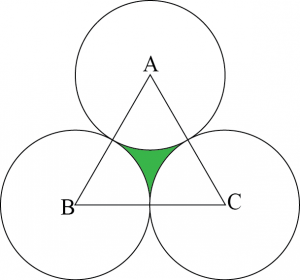
Answer:
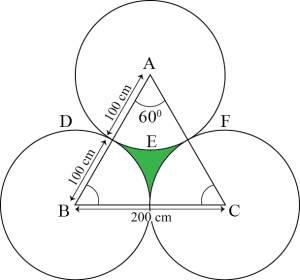
Let the side of the equilateral triangle be a.
Area of equilateral triangle \(= 17320.5\space cm^2\)
\(\frac{\sqrt3}{4}(a)^2=17320.5\)
\(\frac{1.73205}{4}a^2=17320.5\)
\(a^2=4\times10000\)
\(1=200\space cm\)
Each sector is of measure \(60^0\)
Area of sector \(ADEF=\frac{60^0}{360^0}\times\pi r^2\)
\(=\frac{1}{6}\times\pi(100)^2\)
\(=3.14\times\frac{1000}{6}\)
\(=\frac{15700}{3}\space cm^2\)
Area of shaded region = Area of equilateral triangle − 3 × Area of each sector
\(17320.5-3\times\frac{15700}{3}\)
\(=17320.5-15700\)
\(1620.5\space cm^2\)
Question 11: On a square handkerchief, nine circular designs each of radius 7 cm are made (see the given figure). Find the area of the remaining portion of the handkerchief. [Use \(\pi=\frac{22}{7}\)]
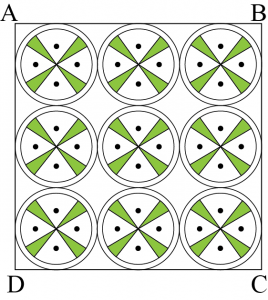
Answer:
From the figure, it can be observed that the side of the square is \(42\space cm\).
Area of square \(= (Side)^2 = (42)^2 = 1764\space cm^2\)
\(=\frac{22}{7}\times(7)^2=154\space cm^2\)
Area of each circle \(\pi r^2\)
Area of \(9\) circles \(=9\times154=154\space cm^2\)
Area of the remaining portion of the handkerchief
\(=1764-1386\)
\(=378\space cm^2\)
Question 12:In the given figure, OACB is a quadrant of circle with centre O and radius 3.5 cm.
If OD = 2 cm, find the area of the
(i) Quadrant OACB
(ii) Shaded region
[Use \(\pi=\frac{22}{7}\)]
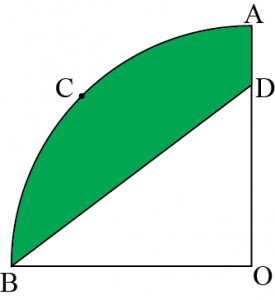
Answer:
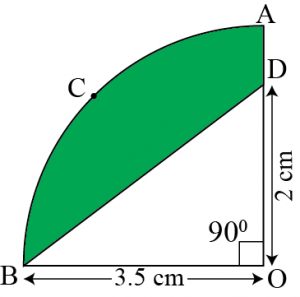
(i) Since \(OACB\) is a quadrant, it will subtend \(90^0\) angle at \(O\).
Area of quadrant \(OACB=\frac{90^0}{360^0}\times \pi r^2\)
(ii) Ara of \(\Delta OBD=\frac{1}{2}\times OB\times OD\)
\(=\frac{1}{2}\times3.5\times 2\)
\(=\frac{1}{2}\times\frac{7}{2}\times2\)
\(=\frac{7}{2}\space cm^2\)
Area of shaded region = Area of quadrant OACB – Ara of \(\Delta OBD\)
\(\frac{77}{8}-\frac{7}{2}\)
\(=\frac{77-28}{8}\)
\(=\frac{49}{8}\space cm^2\)
Question 13: In the given figure, a square OABC is inscribed in a quadrant OPBQ.
If OA = 20 cm, find the area of the shaded region. [Use π = 3.14]

Answer:

In \(\Delta OAB\),
\(OB^2=OA^2+AB^2\)
\(=(20)^2+(20)^2\)
\(=OB20\sqrt2\)
Radius \((r)\) of circle \(20\sqrt2\space cm\)
Area of quadrant \(OPBQ=\frac{90^0}{360^0}\times3.14\times(20\sqrt2)^2\)
\(=\frac{1}{4}\times3.14\times 800\)
\(=628\space cm^2\)
Area of \(OABC=(Side)^2=(20)^2=400\space cm^2\)
Area of shaded region = Area of quadrant OPBQ − Area of OABC
\(= (628 − 400) \space cm^2\)
\(= 228\space cm^2\)
Question 14: \(AB\) and \(CD\) are respectively arcs of two concentric circles of radii \(21\space cm\) and \(7\space cm\) and centre \(O\) (see the given figure). If \(∠AOB = 30^0\), find the area of the shaded region. [Use \(\pi=\frac{22}{7}\)]
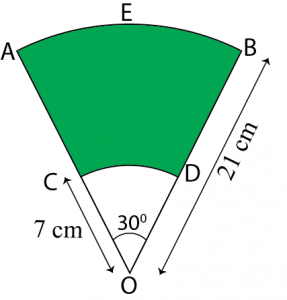
Answer:
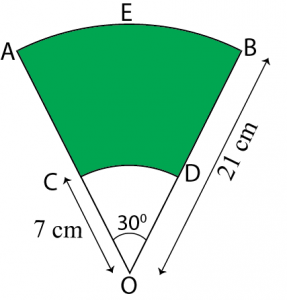
Area of the shaded region = Area of sector OAEB − Area of sector OCFD
\(=\frac{30^0}{360^0}\times\pi\times(21)^2-\frac{30^0}{360^0}\times\pi\times(7)^2\)
\(=\frac{1}{12}\times\pi[(21)^2-(7)^2]\)
\(=\frac{1}{12}\times\frac{22}{7}\times[(21-7)(21+7)]\)
\(=\frac{22\times28}{12\times7}\)
\(=\frac{308}{2}\space cm^2\)
Question 15: In the given figure, ABC is a quadrant of a circle of radius 14 cm and a semicircle is drawn with BC as diameter. Find the area of the shaded region. [Use \(\pi=\frac{22}{7}\)]
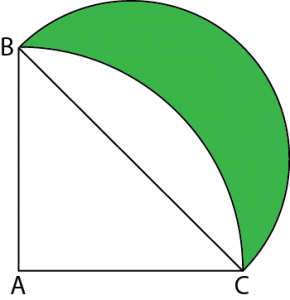
Answer:
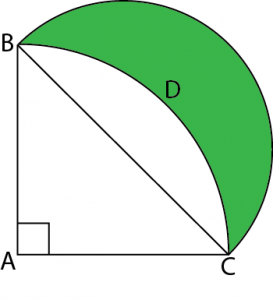
Answer:
As \(ABC\) is a quadrant of the circle, \(∠BAC\) will be of measure \(90^0\).
In \(ΔABC\),
\(BC^2=AC^2+AB^2\)
\(=(14)^2+(14)^2\)
Radius \((r_1)\) of semi-circle drawn on
\(BC=\frac{14\sqrt2}{2}=7\sqrt2\space cm\)
Area of \(\Delta ABC=\frac{1}{2}\times AB\times AC\)
\(=\frac{1}{4}\times\frac{22}{7}\times14\times14\)
\(=154\space cm^2\)
Area of semi-circle drawn on \(BC=\frac{1}{2}\times\pi\times r_1^2=\frac{1}{2}\times\frac{22}{7}(7\sqrt2)^2\)
\(=\frac{1}{2}\times\frac{22}{7}\times98=154\space cm^2\)
Area of shaded region=Area of semi-circle-Area of sector ABDC-Area of ABC
\(=154 − (154 − 98)\)
\(= 98\space cm^2\)
Question 16: Calculate the area of the designed region in the given figure common between the two quadrants of circles of radius 8 cm each. [Use \(\pi=\frac{22}{7}\)]
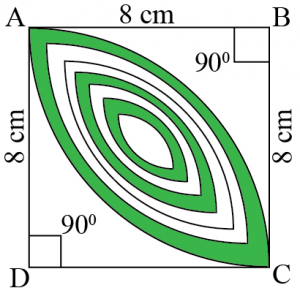
Answer:
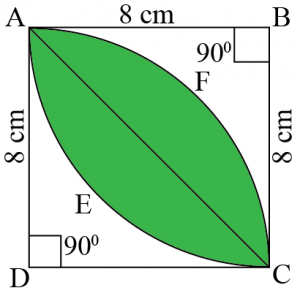
The designed area is the common region between two sectors BAEC and DAFC.
Area of sector
\(BAEC=\frac{90^0}{360^0}\times\frac{22}{7}\times(8)^2\)
\(=\frac{1}{4}\times\frac{22}{7}\times64\)
\(=\frac{22\times16}{7}\)
\(=\frac{352}{7}\space cm^2\)
Area \(\Delta BAC=\frac{1}{2}\times BA\times BC\)
\(=\frac{1}{2}\times 8\times8=32\space cm^2\)
Area of the designed portion = 2 × (Area of segment AEC)
= 2 × (Area of sector BAEC − Area of ΔBAC)
Study materials
- Refernce Books
- NCERT Solutions
- Syllabus
